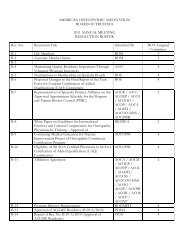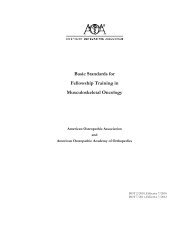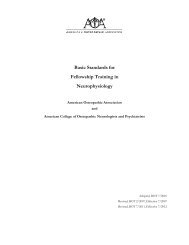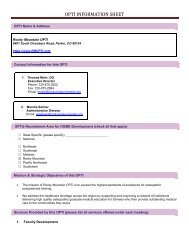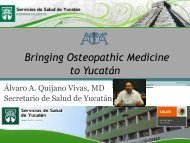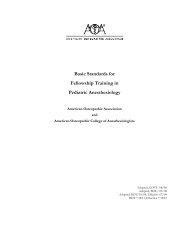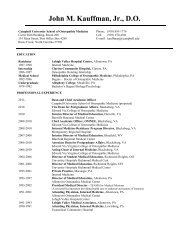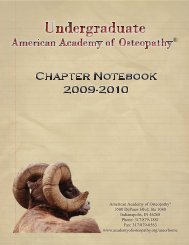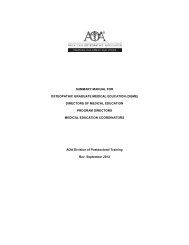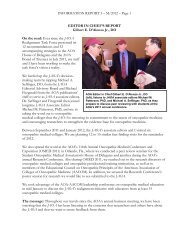Corinne Jedynak-Bell DO - American Osteopathic Association
Corinne Jedynak-Bell DO - American Osteopathic Association
Corinne Jedynak-Bell DO - American Osteopathic Association
You also want an ePaper? Increase the reach of your titles
YUMPU automatically turns print PDFs into web optimized ePapers that Google loves.
<strong>Corinne</strong> <strong>Jedynak</strong>-<strong>Bell</strong> <strong>DO</strong>, MBA, FACOOG<br />
OMED<br />
October 7, 2012<br />
San Diego, California
Overview<br />
• What women want from their physicians?<br />
• Evaluation and Management<br />
• What can cause pain in the Peri and Post Menopausal<br />
patient?<br />
• Sexuality in Older Women<br />
• Breaking Barriers:Taking a Sexual History<br />
• Dyspareunia in the Older women<br />
• The <strong>Osteopathic</strong> Approach<br />
• Techniques of treatment<br />
• Pelvic Diaphragm<br />
• Symphysis Pubis<br />
• Innominate
What women want from their physicians<br />
• To receive personalized care<br />
• To be taken seriously<br />
• To receive an explanation for their condition (more so<br />
than a cure)<br />
• To be reassured
Evaluation and Management<br />
• History and Physical<br />
• Do not interrupt<br />
• Explain what you are going to do on your exam<br />
• Treatment<br />
• Discuss plan of care with possible tests and medications<br />
• Discuss osteopathic treatment
What can cause pain in the Peri and Post Menopausal<br />
patient<br />
<br />
<br />
<br />
<br />
<br />
Gynecologic<br />
• Adhesions, adenomyosis, adnexal cysts, chronic endometritis,<br />
dysmenorrhea, endometriosis, gynecologic malignancies, hormonal<br />
changes, leiomyomata pelvic congestion syndrome, pelvic inflammatory<br />
disease<br />
Gastrointestinal<br />
• Celiac disease, colitis, colon cancer, inflammatory bowel disease, irritable<br />
bowel syndrome<br />
Musculoskeletal<br />
• Chronic pain syndrome, degenerative disk disease, fibromyalgia, levator<br />
ani syndrome, myofascial pain, osteoporsis,, somatization, stress fractures<br />
Psychiatric/neurologic<br />
• Abdominal epilepsy, abdominal migraines, depression, nerve entrapment,<br />
neurologic dysfunction, sleep disturbances<br />
Urologic<br />
• Bladder malignancy, chronic urinary tract infection, interstitial cystitis,<br />
radiation cystitis, organ prolapse, urolithiasis
Sexuality of the older woman<br />
• Level of sexual activity, interest, and enjoyment in<br />
younger years determines sexual behavior with aging<br />
• Decreased sexual activity is associated with:<br />
‣ Poor health<br />
‣ Social issues<br />
‣ Partner availability<br />
‣ Decreased libido<br />
‣ Menopause
Breaking the Barrier: Taking a Sexual History<br />
• Provide comfortable atmosphere<br />
• Frame careful questions<br />
• Ask about any previous negative sexual<br />
experience (e.g., rape, child abuse, domestic<br />
violence)<br />
• Ask about current dyspareunia
Dyspareunia in Older Women<br />
• Due to organic or psychological factors, or a<br />
combination of the two<br />
• Most common organic cause: atrophic<br />
vaginitis due to estrogen deficiency<br />
• Some other causes:<br />
‣ Cystitis<br />
‣ Incontinance<br />
‣ Pelvic organ prolapse<br />
‣ Osteoporosis<br />
‣ Mastectomy<br />
‣ Rheumatoid Arthritis
Pathophysiology<br />
• The support of the pelvic floor is composed<br />
of a network of muscles, fascia and<br />
ligaments<br />
• Damage to any one of these structures may<br />
result in weakening and loss of support<br />
• Pelvic prolapse (“pelvic relaxation”) may<br />
lead to symptoms of pressure, fullness,<br />
urinary and/or fecal incontinence, need for<br />
vaginal splinting
The <strong>Osteopathic</strong> Approach<br />
• Approaching the patient and providing treatment for<br />
many symptoms associated with dyspareunia and<br />
pelvic pain in conjuction with other modalities<br />
• Addressing the WHOLE patient: Social, emotional,<br />
psychological, physical, spiritual<br />
• Looking at the anatomy
Autonomic Innervation<br />
• Innervation of each viscus<br />
• generally follows the course<br />
of<br />
• the arterial supply.<br />
• Sympathetic supply:<br />
• Prostate & Prostatic Urethra: T11-<br />
L1<br />
• Testis & Ovary: T10-11<br />
• Ureter: T11-L2<br />
• Urinary Bladder: T11-L2<br />
• Uterus: T12-L1<br />
• Uterine Tube: T10-L1<br />
• Source: British Gray’s, p. 1306<br />
British Gray’s Anatomy 38 th Ed., p.1293
Pelvic Diaphragm<br />
• The thoracic diaphragm can be monitored for<br />
synchrony of motion between the two –<br />
pelvic & thoracic<br />
• Looking forward from the posterior right<br />
aspect<br />
• View of the ischiorectal fossa –<br />
• Reasonably direct access to one hemidiaphragm<br />
of the pelvic diaphragm.<br />
Moore, Clinically Oriented Anatomy, 4th Edition, 1999, p.400
Lymphatic Congestion<br />
• Thoracic diaphragm function should be<br />
evaluated and treated because it can restrict the<br />
thoracic duct<br />
• Pelvic diaphragm must be evaluated and treated<br />
• Moves passively and synchronously with thoracic<br />
diaphragm
Pelvic Diaphragm<br />
1. Assess for spasm or asymmetry related to prior<br />
surgery involving lower sigmoid, rectum and anal<br />
areas<br />
2. Funnel shaped muscle attaching to lateral walls of<br />
the true pelvis<br />
3. Angles inferior and medially to attach to the<br />
urogenital diaphragm and midline structures of the<br />
urogenital and anal triangles<br />
4. Innervated by pudendal nerve originated from<br />
sacral roots S2,3,4
Pelvic Dysfunction<br />
• Pelvic diaphragm function can be influenced by<br />
sacral and pelvic function.<br />
• Focus upon pelvic dysfunction and its contribution to fluid<br />
congestion, as well as sub-optimal parasympathetic function.<br />
• Pubic & Innominate dysfunction change tensions in the urogenital<br />
diaphragm and the levator ani.<br />
• Thus fluid congestions may be augmented by decreased tissue<br />
motion
Pubic & Innominate Dysfunction<br />
• Parasympathetic changes occur with suboptimal<br />
sacral motion and the increased tensions in the<br />
pelvic tissues<br />
• Sympathetic changes for the same reasons<br />
especially around the sacral sympathetic chain and<br />
the ganglion impar at its end.<br />
• In summary, innominate dysfunction can influence:<br />
• Fluid congestion<br />
• Parasympathetics<br />
• Sympathetics
Symphysis Pubis<br />
• Superior and Inferior shearing mechanics seen<br />
with pubic dysfunction<br />
• Seen post partum<br />
• Also seen in strenuous use of adductor muscles<br />
of thighs or trauma
Superior Pubes<br />
•Physician uses the<br />
shoulder to compress from<br />
the knee toward the<br />
acetabulum<br />
•Physician internally rotates<br />
the lower extremity<br />
•The monitoring finger can<br />
feel the pubes descend
Inferior Pubes<br />
•Compression is again the<br />
first step<br />
•Followed by external<br />
rotation of the lower<br />
extremity to carry an<br />
inferior pubes superior.<br />
•The monitoring finger<br />
can feel the pubes<br />
ascend.
Innominate: Rotated Anterior<br />
•Caudad Hand: Holds knee to maintain eversion at the hip.<br />
•Cephalad Hand: Directs force on the ASIS superior and posterior<br />
•Patient: Gently and slowly carries the foot along the medial aspect of<br />
the opposite leg until straight.
Innominate: Rotated Posterior<br />
•Same technique, except<br />
•Cephalad Hand: contacts the<br />
ischial tuberosity and carries it<br />
superior/posterior
Summary<br />
1. <strong>Osteopathic</strong> treatment of the lower GI tract involves<br />
evaluating the patient’s entire health<br />
- Nutritional status, psychological stress<br />
2. Somatic influences on the pelvis must be evaluated<br />
and treated<br />
- Short leg syndrome, lumbar & sacral strain/sprain, post-partum<br />
considerations, innominate upslip<br />
3. The potency of further therapy hinges on the<br />
manipulative treatment.<br />
- For antibiotics to be fully effective, blood flow and lymphatic<br />
drainage must be optimized
Somatic Dysfunction<br />
• <strong>Osteopathic</strong> manipulative treatment is directed<br />
toward:<br />
• Improving blood flow<br />
• Improving lymphatic flow<br />
• Balancing autonomic impulses to and from the bowel
References<br />
1. Cervero F. Sensory innervation of the viscera: peripheral basis of visceral pain. Physiol Rev 1994;<br />
74:95.<br />
2. Danby CS, Margesson LJ. Approach to the diagnosis and treatment of vulvar pain. Dermatol Ther<br />
2010; 23:485.<br />
3. Glatt AE, Zinner SH, McCormack WM. The prevalence of dyspareunia. Obstet Gynecol 1990;<br />
75:433.<br />
4. Jamieson DJ, Steege JF. The prevalence of dysmenorrhea, dyspareunia, pelvic pain, and irritable<br />
bowel syndrome in primary care practices. Obstet Gynecol 1996; 87:55.<br />
5. Kuchera, Michael L. and Kuchera, William A.,<strong>Osteopathic</strong> Considerations in Systemic<br />
Dysfunction. 2nd Edition, 1994. p 94 – 116.<br />
6. Latthe P, Latthe M, Say L, et al. WHO systematic review of prevalence of chronic pelvic pain: a<br />
neglected reproductive health morbidity. BMC Public Health 2006; 6:177.<br />
7. Meana M, Binik YM, Khalife S, Cohen DR. Biopsychosocial profile of women with dyspareunia.<br />
Obstet Gynecol 1997; 90:583.<br />
8. Shifren JL, Monz BU, Russo PA, et al. Sexual problems and distress in United States women:<br />
prevalence and correlates. Obstet Gynecol 2008; 112:970.<br />
9. Ward, Robert C., ed. Foundations For <strong>Osteopathic</strong>Medicine. Lippincott Williams & Wilkins. 2003.<br />
p 762-783.<br />
10. Yates, Herbert A. Counterstrain: A Handbook of <strong>Osteopathic</strong> Technique. Y Knot Publishers. 1995.<br />
+ Black references are <strong>Osteopathic</strong>



